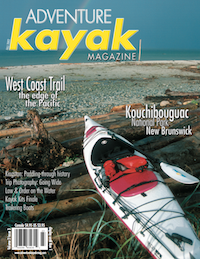Many sea kayakers will still knowledgeably expound on how the notion of rolling a fully loaded sea kayak is just plain silly. These self-proclaimed experts will even say that learning to roll is dangerous to your health screaming, “It takes only twelve pounds of pressure to dislocate a shoul- der!” Yeah, and it only takes about three pounds of hot air to push many sea kayakers over.
The origins of the you can’t roll a sea kayak attitude grew from the very pos- itive and inclusive approach taken to marketing the sport in North America. Kayak touring has been promoted as an activity that anyone can do.And that’s true.Almost everyone loves to get out on the water and skills like the roll should never be a prerequisite. The sport should never become elitist in the way that it has in some places, nor however, should the skill set available to paddlers be misrepresented in an attempt to foster growth of the industry.
In the U.K. for instance, the sport of sea kayaking is promoted quite differently. It is a far more exclusive affair governed by the British Canoe Union (BCU). Ostensibly set up as a club, aspiring paddlers work their way through a rigorous testing system and are judged by accredited coaches in order to improve their skill rating. To its credit, paddlers do typically have a very good skill set under this system but it also discourages many potential paddlers.
In America, promoters of sea kayaking say it is available to all: the old, the young, the wounded and infirm. As long as you have the cash for a Kevlar sea kayak they will encourage you to paddle it. Of course you’ll also need a veritable mountain of res- cue accessories. And no, you don’t have to learn any pesky skills or even get wet. Rolling? That’s much too difficult. Damn near impossible really. It’s not necessary and besides you’ll get cold and wet… Brrrr. But here, buy this fleece and dry top just in case. And instead of learning to roll, buy a paddle float, it will look really technical on the deck of your new boat!
Isay learn to roll dependably and it will immediately replace all other self-rescues as your primary choice for righting your capsized kayak. A dependable roll is the ultimate self-rescue technique, period. End of story.
Surely, you are thinking to yourself, this guy can’t be suggesting that rolling is a substitute for the much loved and cherished paddle float rescue, not to mention the myriad of other solo rescue procedures filling the how-to books over-flowing your kayak hatches? Yup, that’s exactly what I’m proposing; rolling is the first and best option. This does not mean that I do not carry a paddle float as a back-up. And what is this obsession with the paddle float anyway? Beginners insist that they need one with their rental boat and they tell me it is unsafe and dangerous to be without one. But when asked, their blank looks reveal a beautifully humbling moment of realization,“Umm, no. How do I use it?”
Sorry to keep kicking a sacred cow, but rolling means staying in the boat, reducing immersion time to seconds instead of minutes. It also reduces what gets immersed by about fifty percent, keeping the lower body relatively dry. Seconds after the capsize, you are upright in an active position to continue paddling, not wallowing around surrounded by gear, wrestling a beach ball float onto your paddle to perform a manoeuvre created by Spiderman and made famous by some bearded old windbag in a Tilley hat.
Afriend of mine has been known to refer to a day out in flat, calm, sunny conditions as,“the sort of paddling that gives sea kayaking a bad name.”What she’s on about is the joy of paddling in wind and waves, catching surf rides and, yes, occasionally even getting knocked over. For too many otherwise capable paddlers, it is the fear of capsizing that limits them to flat, boring conditions. Just one good surf ride will hook many paddlers and launch them on a quest to build the skills needed to play in the surf zone or enjoy following seas and big swells. If that’s not enough, knowing that you won’t have to exit your boat unexpectedly means that you can paddle nude.
Despite what a few anointed gurus might wish you to believe there is no hocus pocus, magic beans or philosopher’s stone required to learn to roll a kayak. If you are relatively fit and have the desire, chances are you are a roller waiting to happen. Give it a bash. Be good to yourself, get qualified instruction and be patient with your progress. Even if you decide that rolling isn’t for you, you’ll have learned more about your sport and become more comfortable upside down in your boat.The ability to roll will change the whole way you paddle and give you the confidence to play in your boat like never before.
And if you happen to do a roll in front of boats self-righting?” Nod vigorously and say one of your buddies who’s in a kayak for the yes.





What’s with the final paragraph? Something was lost or scrambled in transcription.
| And if you happen to do a roll in front of boats self-righting?” Nod vigorously and say one of your buddies who’s in a kayak for the yes.